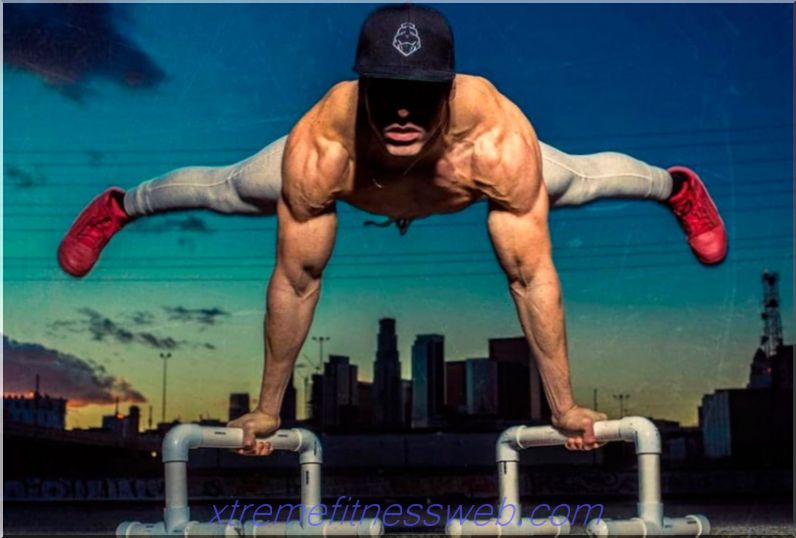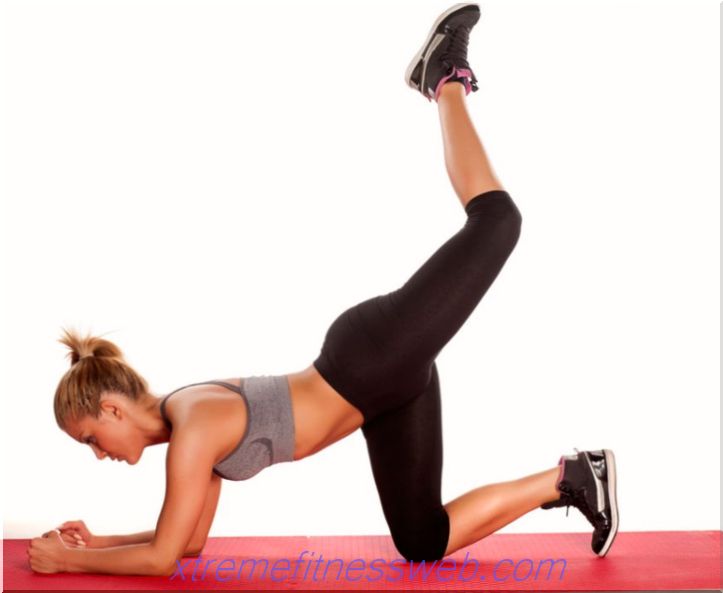- Types of press rollers
- What muscles can be trained
- 9 exercises with a roller for the press
- Safety regulations

A press for a press is called a sports apparatus, which has a fairly simple design. It is a handle divided on the left and right side by a wheel, which is located in the middle, so that it is as comfortable and convenient to hold it with both hands. The simplicity of the device does not mean that it has low efficiency.
Exercises performed with the roller pump well the muscles of the abdomen, back and triceps. This is true only when the execution technique is followed. Training with a roller is highly effective, and for most exercises you need to be a fairly experienced athlete.
Content
- 1 Types of press rollers
- 2 What muscles can be trained
- 3 9 exercises with a roller for the press
- 3.1 Plank
- 3.2 Rolling from the knees
- 3.3 Wall rental
- 3.4 Front rolling with a wide and narrow rack
- 3.5 Oblique
- 3.6 One-handed
- 3.7 On one leg
- 3.8 fold
- 3.9 Oblique fold
- 3.10 Peak
- 4 Safety Rules
Types of press rollers

Sports equipment must be such as to maintain a good body and allow you to move without jerking and back and forth. Gymnastic hard roller has a device that allows you to practice on a tile or rug without making intermittent movements. A device with a double wheel has a wide base and distributes the mass as evenly as possible.
It is recommended to choose a wheel so that it retains its stability under the weight of the athlete during the rental. For beginners, I’m sorry to just work with rollers that have two wheels in parallel or one, but quite wide. To achieve good stability, it is necessary to choose a rubberized wheel. It is stable on absolutely any surface. The device should have ergonomic handles made of foam.
This material allows you to firmly hold the wheel and maintain balance well. There are designs equipped not only with handles, but also with pedals. These types of videos help diversify the complex of exercises performed through this sports equipment. The handles are required to fit snugly on the palms, and the pedals help to keep the feet without any slippage.
What muscles can be trained

Exercises with a roller for the press, requires good preparation. Without well-developed muscle mass, it is impossible to provide adequate support for body mass when rolling is done. The use of the roller makes the body move, and the spine stretches during the entire movement. This poses a challenge for deep-lying stabilizers of the spine and straight, as well as transverse muscle tissue of the abdomen.
Such an impact makes the roller an ideal device for pumping relief and strong muscles of the press. The movement also involves auxiliary femoral, brachial, latissimus muscles, as well as triceps. They are responsible for stabilizing the body from the shoulder girdle to the very toes, which helps maintain balance when the wheel rolls under the body.
9 exercises with a roller for the press
Work with the device should be from a simple bar, but relying on a roller wheel, and then move on to more complex ones, that is, when there is complete confidence that you can proceed to exercises that involve the knees, and then to full rental and other more complex variations. An absolute beginner can work with a fitball first.
Strap

The bar, performed with the help of the wheel, strengthens the stabilizing muscles, and also helps to feel how to properly maintain the roller and balance.
Technique:
- stand on all fours in front of the gymnastic roller;
- grasp the handle with both hands, directing the palms down;
- the body is raised to the position of the bar, and then straightened in a line from the head to the very heels;
- the housing is kept in constant voltage and is held in position for 30-60 seconds.
Do from three to four repetitions.
Rolling off your knees

This is the next most difficult exercise, which allows you to move to a new level of complexity. At first, rolling from the knees is best done with a folded towel or flat pillow.
Performance:
- kneel down, grab handles and stretch out arms;
- to avoid arching the lower back, strain the abdominal muscles;
- roll slowly forward as much as possible;
- return to the starting position.
The arms are best extended as far forward as possible, so that the chest is slightly higher than the floor. If this is difficult to do, they are lowered by half. The number of repetitions is from five to ten times.
It is best to start doing the exercise with small ranges, increasing progress gradually. Each athlete chooses the optimal rental length for himself. You need to move until you are able to come back through the use of the abdominal muscles.
Wall rental

This is another option for beginners, which allows you to perfectly maintain both a fixed roller length and the pace of training. Using the wall as a focal point. It is recommended to carry out rental rather slowly.
Execution:
- become about a meter from the surface of the wall;
- rolling from the knees so that the roller touches the wall;
- return to their original position.
Five to ten repetitions are made.
Front rolling with a wide and narrow stand

Carrying out a full rental using a roller is an exercise of an increased level of complexity, but with a wide stance it is much easier to do. When the exercise is mastered, the position is changed, narrowing the distance between the legs until a full rental is completed.
Performance:
- legs set across the width of the shoulder girdle, bending at the waist, and then grasping the handle of the roller lying on the floor;
- keep your back and arms straight and roll forward until the body is horizontal to the floor surface, rest your feet on your fingers in the same way as push-ups;
- the wheel is rolled back towards the legs and bent again at the waist to return to the starting position.
Do from five to six repetitions.
When rolled from the knees in a wide rack mastered, go to full rental, but with a narrow rack. Exercise allows you to effectively use the muscles of the whole body and involves the muscles of the shoulders, back, abs, arms.
Oblique rental

The next option after the frontal exercise is oblique rental. The main emphasis in the exercise is on the oblique muscle groups of the abdomen.
Execution:
- stand on both knees and grasp the arms;
- but, instead of a direct movement, they begin to roll forward, and then turn at an acute angle (45 degrees), completing the exercise in this direction;
- return to the starting position, and then slowly roll at the selected angle to the right.
Do about five or ten repetitions.
With one hand

This rental is a complex version of the frontal. The hand held by the roller holds the weight. The main advantage of this exercise is the creation of additional tension on the stabilizing muscles. Initially, it is given quite difficult, so you should not start with the full version. First, it’s best to practice rolling with your knees.
Performance:
- kneel down or stand right in front of the roller, depending on whether they practice or work;
- bend along the waistline, and then grasp the handle with one hand;
- slowly moving forward, focusing on the muscle groups of the body;
- return to the starting position.
Do from three to five repetitions. When they make a rental, make sure that the case does not tip over to the side. To maintain balance, it is allowed to adhere to the floor surface with your free hand.
On one leg
It is a sophisticated version that requires a lot of strength from muscle stabilizers. Proceed to the implementation of this exercise should be after the development of full rental on two legs.
Execution:
- stand right in front of the shell;
- bend at the waist and take hold of the wheel;
- keep your back straight, and arms extend and roll forward;
- return to the starting position, standing on one leg and again bend at the waist.
They make about five to ten repetitions.
Fold

This variation of rental requires the use of a roller, which is equipped with special pedals for the legs, since the rental is carried out not with the hands, but with the lower limbs. This exercise involves the arms, shoulder girdle, oblique and abdominal muscles.
Performance:
- the feet are fixed in special pedal devices and become the bar, holding arms straightened in the elbow joints under the shoulders;
- roll the wheel with legs so that both knees move to the chest, holding the upper part motionless;
- straightening the knee joints, until they again return to the position of the bar.
Do from eight to twelve repetitions.
Oblique fold

This variation involves stabilizing muscles and oblique presses.
Execution:
- the feet are fixed in the pedals and stand on the bar, stretching out your arms in front of the shoulder joints;
- the wheel is rolled with legs and moved to the right elbow;
- return to the bar position and roll to the left side.
Perform eight to twelve repetitions.
Peak

This variation resembles a crease, but the legs are kept straight:
- the feet are also fixed on the pedals and stand on the bar, stretching out the arms under the shoulder joints;
- engage the muscle groups of the body and slowly roll the roller wheel to the upper part, bend at the hips, lifting the gluteal muscles up;
- roll the roller to its original position.
Do from eight to twelve repetitions.
Safety regulations

The press roller may seem quite simple to use, but it requires serious efforts from the athlete, and, most importantly, well-developed muscle groups of the body, since they are activated during the rental.
If the exercises are done incorrectly, then due to the excessive load exerted on the back muscles and hip flexors, the likelihood of injury is increased. They are not recommended for those people who have problems with an intervertebral hernia or lower back.
In order to comply with the correct execution technique and not get injured while working with the roller, you should adhere to several rules:
- always check that the movement is carried out with the wheel, and not because of the movement of the floor mat;
- Do not bend in the lower back and do not allow the body or knees to touch the surface of the floor;
- always keep your back, legs and arms straight;
- to do the rental, regardless of the degree of difficulty, slowly, increasing progress gradually;
- reduce the range of movement, if there is pain in the shoulder girdle;
- concentrate on the abdominal muscles.
Proper training with a press roll involves maintaining a slow speed. When the back begins to bend, it means rolling is either done from the knees, or shorten the length. The head should be in a neutral position, and the chin should be slightly tightened, which will help protect the neck and lower back.
It is recommended to perform exercises with a roller after a good workout, since they immediately give an intense load to the muscles of the whole body. At the end of the training, they do a hitch, that is, a good stretch. Beginners should use the wheel twice a week, and only then bring the number of training days with it up to five times. This also applies to repetitions. You need to start with two or three, and then increase the pace.







